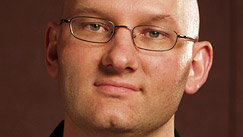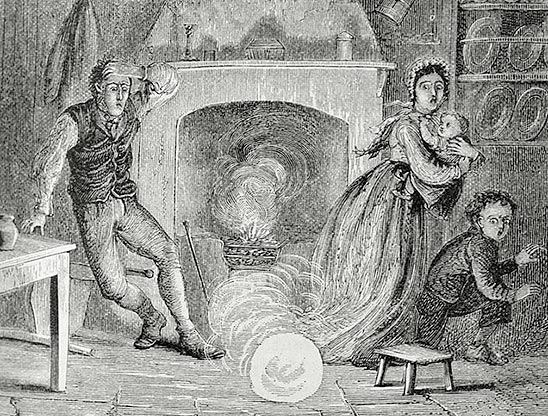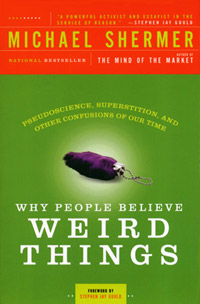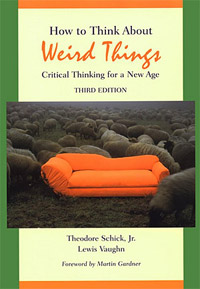
Skepticality

Christmas Magic?
The holiday season can be a stressful time for anyone, but for those parents raising their children to be critical thinkers and skeptics, there are some special challenges — namely, to Santa or not to Santa?
This week, on a special holiday episode of Skepticality, Derek & Swoopy talk with Heidi Anderson (whose article, “Skeptical Parenting: Raising Young Critical Thinkers” appears in the current issue of the Skeptical Inquirer) and her seven-year-old son Hollis. Young Hollis, it turns out, has his own opinions on Santa, science and truth…
MonsterTalk

I’m Gonna Get You,
Goat Sucker!
The most famous of the Latin American cryptids is El Chupacabra, the goat sucker. This episode of MonsterTalk examines the lore behind this slinking, sinister, blood-sucking creature. Is it a real animal? A creation of secret scientific experiments? An alien’s pet accidentally released on Earth?
Co-host Benjamin Radford takes the guest spot this week as we discuss the research behind his upcoming book (tentatively titled) Tracking the Vampire: Chupacabras in Fact, Fiction and Folklore.
In this week’s eSkeptic, Steuart Campbell discusses the evidence (or lack thereof) of the phenomenon known as ball lightning. Steuart Campbell is a Scottish science writer born in 1937. Originally an architect, he has a degree in science and applied mathematics. He is the author of many skeptical articles on unsual phenomena and mysteries. In particular he is the author of The UFO Mystery Solved, The Rise and Fall of Jesus and The Loch Ness Monster: The Evidence.

The Case Against Ball Lightning
by Steuart Campbell
Ball lightning (BL) is popularly described as a slowly-moving luminous ball not more than twelve inches (30 cm) in diameter occasionally seen at ground level during a thunderstorm. Scientists usually understand it as an electrical discharge phenomenon somehow associated with normal lightning.
The existence of BL is controversial with opinions and explanations changing over time. While many theories have been advanced to explain it, none of them account for all the reported characteristics, Further, it has not been created in laboratory conditions with all these characteristics, and reliable accounts of it are rare and often suspect. Because of perceptual and memory problems, anecdotal evidence is of doubtful value. There is no photograph, film or video recording that can be accepted unreservedly as showing BL. Many forget the null hypothesis, which has explained many postulated phenomena, such as phlogiston and the ether, that turn out to be nonexistent. The null hypothesis may also explains BL, which could be a chimera, a pseudo-phenomenon.
Skepticism regarding the existence of BL goes back at least to Michael Faraday and Francois Arago in the nineteenth century. In 1839 Faraday, while allowing that balls of fire might appear in the atmosphere, doubted that they had anything to do with lightning or atmospheric electricity (Barry, p.133). More recently, Karl Berger reported that, in over 20 years of study as a meteorologist and lightning investigator, he had never observed BL. He concluded that it did not exist (Barry, p.133). Other scientists have reached the same conclusion. James Lovelock put tales of BL in the same category as those of spontaneous human combustion and crop circles (Lovelock, p. 86). Even Barry allows that unbiased examination of reports leads to the conclusion that a great percentage are highly questionable and could be interpreted in several ways (op. cit. p.134). Among those ways is the persistence of vision theory proposed by Lord Kelvin in 1888. He claimed that the uniform size reported in many cases was ascribed to an illusion associated with the blind spot in the eye (Singer, p.19). Lovelock reported such a case after a lightning flash (p. 86). Other sources of deception proposed have been will-o’-the-wisp and owls with luminous wings, but the existence of both of these is itself doubtful. In recent years, some scientists have accepted the existence of BL, but with little evidence.
Reports of BL suffer from defects inherent in the human perceptual and memory systems. Because both perception and memory are reconstructive processes, what we perceive is not necessarily what the sense organs receive. This is demonstrated by various well-known optical illusions, such as the moon illusion. Distant stationary lights are subject to several movement illusions, all of which attribute movement to the light. The most famous is the autokinetic illusion, in which a stationary light (usually a star) will appear to move about at random.
The size or distance of an unknown object cannot be determined by observers without additional information. Observers usually make a guess about either the size or distance of an object and then determine the other parameter from their guess. In fact both can be wrong. The size of distant objects seen near the horizon can be exaggerated (the moon illusion), as can an object’s altitude (angle above the horizon). Nor can observers usually distinguish between change in size of an object and change in its distance, usually interpreting a change in size as a change in distance. A phenomenon called size constancy can interfere with size perception. Even estimates of time-span are unreliable; fascination tends to shorten it. Estimates of brightness are meaningless (it is a relative term) and observers tend to make false associations, drawing unwarranted conclusions from what they perceive. They may associate effects with the wrong cause. In the case of anomalous luminous phenomena, observers try to identify them by reference to the models they carry in their minds. Clearly they can only identify a phenomenon as BL if they have heard of it. Conversely they are likely to identify an anomalous object as BL simply because they have heard of it.
item of interest…
In this age of supposed scientific enlightenment, many people still believe in mind reading, past-life regression theory, New Age hokum, and alien abduction. A no-holds-barred assault on popular superstitions and prejudices, this book debunks these nonsensical claims and explores the very human reasons people find otherworldly phenomena, conspiracy theories, and cults so appealing.
ORDER the paperback
Nor is memory much more reliable than perception. People who report BL and who have heard about other reports may, inadvertently, draw on these previous reports for their own report. Tests show that reliability decreases with time and it is strongly suspected that observers attempt to make facts fit theory.
Consequently, genuine anecdotal reports of BL must be regarded with suspicion. Observers are mostly unaware of the distortions involved in perception and memory. Worse still, asking people if they have seen BL begs the question of its existence and ignores their inability to distinguish it (if it exists) from other phenomena. The question plants a concept in the mind which will distort the memory of any genuine perception. Such a question should not be asked and surveys based on it are worthless.
The contradictory results obtained from reports were noted by an early investigator, F. von Lepel (Singer, p. 62). According to reports, BL occurs in any type of weather, not just storms; it can be any color; it can be motionless or moving at any speed, often against the wind; it can disappear violently or silently; it may follow wires or edges or travel independently; it may be outside or inside; its life time varies from a fraction of a second to several minutes; its shape can be spherical or pear-shaped; it is either silent or noisy; etc.
In other words, the phenomenon exhibits no consistent characteristics and appears to be all things to all observers. One investigator commented that there are very few natural phenomena that observation makes more difficult to explain (Singer, p. 62). However such contradictions might be explained if the observers are reporting many different phenomena, none of which are actually BL. Among the objects mistaken for BL are bright astronomical objects at low altitude, sometimes seen in mirage (Campbell 1988a).
Because anecdotal reports are unreliable, so are illustrations based on these reports. However, it is more difficult to explain reports of physical damage and photographic evidence. It is sometimes alleged that BL can penetrate closed windows and the literature contains several alleged examples. When a mysterious hole appeared in a window of his department during a storm, a professor of meteorology in Edinburgh concluded that BL was the cause. However later investigation showed a simpler explanation—mechanical damage (Campbell 1981a). Almost circular cracks can appear in sheet glass when subjected to the appropriate sudden stress.
Reports of extensive damage such as fires or explosions may more easily be explained as the result of ordinary lightning strikes. Such reports are not clarified by the popular belief that lightning strikes are the result of something called a ‘thunderbolt’.
Barry demonstrated that a long-lived luminous ball phenomenon can be produced by spark-initiated combustion of low-density hydrocarbon gas at atmospheric pressure (p.108). This may explain the 1975 report from a housewife in Smethwick (English Midlands) that BL appeared over her gas cooker (Campbell 1988b). Normal lightning may ignite hydrocarbon gases in the atmosphere, producing similar phenomena, but this is not what is understood as BL.
Photographs alleged to show BL are as suspect as anecdotal reports and sketches. The camera cannot lie, but what it shows can be misinterpreted and the photographer can lie. Until the early 1970s, a photograph taken in 1961 at Castleford (Yorkshire, England) had been interpreted as showing the path of BL. Even New Scientist magazine described it as the ‘Path of a Thunderbolt’. But a decade later it was claimed that it showed the pulsed trace from a street lamp (Davies and Standler) and a decade after that it was demonstrated that this was correct (Campbell 1981b): the photographer incautiously moved the camera while the shutter was still open. A Russian photograph taken in 1957 had the same explanation, but not before a member of the Soviet Academy of Sciences endorsed the picture on the basis of similar pictures he had seen in a 1939 US journal (Campbell 1987). He did not know that the pictures were all produced by lamps, presumably as hoaxes.
Many alleged pictures of BL are deliberate fakes. They appear to include the picture produced in 1966 by a former Canadian Air Force pilot, which misled the American editor of Aviation Week and Space Technology, who used it on the cover of his skeptical books on UFOs (Campbell 1988c).
item of interest…
James Randi calls this textbook “the most powerful, comprehensive, and readable collections of examples, explanations and caveats that I could have ever hoped for.” A library must!
ORDER the paperback
Although it is fairly easy to take a photograph, or to fake one, which many mistakenly interpret as showing BL, it should be less easy to produce a film or video sequence that could fool anyone. However, in 1973 a film appeared that was claimed to show BL traveling slowly across the horizon near Aylesbury (England). It shows a bright ball of light moving on a steady horizontal course for twenty-three seconds until it suddenly vanishes. Because it was reported initially as a UFO, the film has been shown many times at UFO conferences and has featured in a BBC TV program about UFOs. But it was also thought that it showed BL. Later it was demonstrated that the ‘ball’ was burning fuel being dumped from a damaged US fighter-bomber; the aircraft itself, nearly four miles (6 km) away, was not visible beside the fireball and too far away to be heard (Campbell 1991).
In 1989 a TV station in south-east England screened a video of a smudgy spherical object with a hole which was captured accidentally as the videographer attempted to video normal lightning; he had not seen anything unusual during the recording. The videographer thought it might show BL and this explanation was initially endorsed by Professor Roger Jennison of the University of Kent (he has himself reported seeing BL). However, it was later demonstrated that the object in the sequence was a combination of an artifact of the camera itself and a distant street light (Bergstrom and Campbell).
References
- Bergstrom, Arne and Steuart Campbell. 1991. “The Ashford ‘Ball Lightning’ Video Explained.” pp. 185–190 in J. Meteorology, UK. Vol. 16, No. 160.
- Barry, James Dale. 1980. Ball Lightning and Bead Lightning: Extreme Forms of Atmospheric Electricity. New York: Plenum Press.
- Campbell, Steuart. 1981a. “Not Lightning Damage.” pp. 66–71 in Weather, Vol. 36, No. 3.
- ___. 1981b. “How Not to Photograph Ball Lightning.” pp. 1096–1097/1105 in Brit. J. of Photography, Vol. 128, No. 6326.
- ___. 1987. “Ball Lightning Exposed! Another Picture puzzle…” pp. 1537–1538 in Brit. J. of Photography. Vol. 134, No. 6645.
- ___. 1988a. “Russian accounts of ball lightning.” pp. 126–128 in J. of Meteorology, UK. Vol. 13, No. 128.
- ___. 1988b. “The Smethwick Ball Lightning Report.” pp. 391–393 in J. of Meteorology, UK. Vol.13, No. 134.
- ___. 1988c. “The Childerhose UFO: fact or fiction?” P. 72 in Brit. J. of Photography, Vol. 135, No. 6686.
- ___. 1991. “Fireball by Day.” pp. 22–23 in Brit. J. of Photography, Vol. 138, No. 6814.
- Davies, D.W. and R.B. Standler. 1972. “Ball lightning.” P. 144 in Nature, 240 (17 November).
- Lovelock, J. 2001 Homage to Gaia. Oxford University Press, USA
- Singer, Stanley. 1971. The Nature of Ball Lightning. New York: Plenum Press.

NEW ON SKEPTICBLOG.ORG
What, if Anything, Can Skeptics Say About Science?
Daniel Loxton argues that there are severe limits on the kinds of scientific arguments into which skeptics may responsibly wade. He proposes four rules of thumb for skeptical discussion of mainstream science.

NEW ON MICHAELSHERMER.COM
Scientific American column for December
Read the December issue of Michael Shermer’s Scientific American column for free on michaelshermer.com: Political Science: Psychological research reveals how and why liberals and conservatives differ.
NEW ON TRUE/SLANT
The Afterlife Comes to Larry King Live
Shermer shares his experience debating about the afterlife with Dr. Sanjay Gupta, Dr. Deepak Chopra, and Dinesh D’Souza on an episode of Larry King Live.

Want to Earn a Cool $10,000
and Promote Reason?
Check out this new video contest from our friend Sam Harris, head of The Reason Project, as a means of promoting science, reason, and secular values. You all know Sam as the author of the wildly popular books The End of Faith and Letter to a Christian Nation. He is now becoming actively involved in multi-media promotion of science so I encourage you all to enter this cool contest, earn a few bucks, and help save the world in the process!













